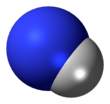Imidogen
 | |||
| |||
| Names | |||
|---|---|---|---|
| IUPAC name λ1-Azanylidene[1] | |||
| Other names Aminylene Azanylene hydridonitrogen | |||
| Identifiers | |||
CAS Number |
| ||
3D model (JSmol) |
| ||
| ChEBI |
| ||
| ChemSpider |
| ||
Gmelin Reference | 66 | ||
PubChem CID |
| ||
CompTox Dashboard (EPA) |
| ||
InChI
| |||
| |||
| Properties | |||
Chemical formula | HN | ||
| Molar mass | 15.015 g·mol−1 | ||
| Conjugate acid | Nitrenium ion | ||
| Structure | |||
Molecular shape | linear | ||
| Thermochemistry | |||
Heat capacity (C) | 21.19 J K−1 mol−1 | ||
Std molar entropy (S⦵298) | 181.22 kJ K−1 mol−1 | ||
Std enthalpy of formation (ΔfH⦵298) | 358.43 kJ mol−1 | ||
Except where otherwise noted, data are given for materials in their standard state (at 25 °C [77 °F], 100 kPa). Infobox references | |||
Imidogen is an inorganic compound with the chemical formula NH.[2] Like other simple radicals, it is highly reactive and consequently short-lived except as a dilute gas. Its behavior depends on its spin multiplicity.
Production and properties
Imidogen can be generated by electrical discharge in an atmosphere of ammonia.[3]
Imidogen has a large rotational splitting and a weak spin–spin interaction, therefore it will be less likely to undergo collision-induced Zeeman transitions.[3] Ground-state imidogen can be magnetically trapped using buffer-gas loading from a molecular beam.[3]
The ground state of imidogen is a triplet, with a singlet excited state only slightly higher in energy.[4]
The first excited state (a1Δ) has a long lifetime as its relaxation to ground state (X3Σ−) is spin-forbidden.[5] Imidogen undergoes collision-induced intersystem crossing.[4]
Reactivity
Ignoring hydrogen atoms, imidogen is isoelectronic with carbene (CH2) and oxygen (O) atoms, and it exhibits comparable reactivity.[5] The first excited state can be detected by laser-induced fluorescence (LIF).[5] LIF methods allow for detection of depletion, production, and chemical products of NH. It reacts with nitric oxide (NO):
- NH + NO → N2 + OH
- NH + NO → N2O + H
The former reaction is more favorable with a ΔH0 of −408±2 kJ/mol compared to a ΔH0 of −147±2 kJ/mol for the latter reaction.[6]
Nomenclature
The trivial name nitrene is the preferred IUPAC name. The systematic names, λ1-azane and hydridonitrogen, valid IUPAC names, are constructed according to the substitutive and additive nomenclatures, respectively.
In appropriate contexts, imidogen can be viewed as ammonia with two hydrogen atoms removed, and as such, azylidene may be used as a context-specific systematic name, according to substitutive nomenclature. By default, this name pays no regard to the radicality of the imidogen molecule. Although, in even more specific context, it can also name the non-radical state, whereas the diradical state is named azanediyl.
Astrochemistry
Interstellar NH was identified in the diffuse clouds toward ζ Persei and HD 27778 from high-resolution high-signal-to-noise spectra of the NH A3Π→X3Σ (0,0) absorption band near 3358 Å.[7] A temperature of about 30 K (−243 °C) favored an efficient production of CN from NH within the diffuse cloud.[8][9][7]
Reactions relevant to astrochemistry
Chemical reactions[10][11] Reaction Rate constant Rate/[H2]2 N + H− → NH + e− 1×10−9 3.5×10−18 NH2 + O → NH + OH 2.546×10−13 1.4×10−13 NH+
2 + e− → NH + H3.976×10−7 2.19×10−21 NH+
3 + e− → NH + H + H8.49×10−7 2.89×10−19 NH + N → N2 + H 4.98×10−11 4.36×10−16 NH + O → OH + N 1.16×10−11 1.54×10−14 NH + C+ → CN+ + H 7.8×10−10 4.9×10−19 NH + H+
3 → NH+
2 + H21.3×10−9 3.18×10−19 NH + H+ → NH+ + H 2.1×10−9 4.05×10−20
Within diffuse clouds H− + N → NH + e− is a major formation mechanism. Near chemical equilibrium important NH formation mechanisms are recombinations of NH+
2 and NH+
3 ions with electrons. Depending on the radiation field in the diffuse cloud, NH2 can also contribute.
NH is destroyed in diffuse clouds by photodissociation and photoionization. In dense clouds NH is destroyed by reactions with atomic oxygen and nitrogen. O+ and N+ form OH and NH in diffuse clouds. NH is involved in creating N2, OH, H, CN+, CH, N, NH+
2, NH+ for the interstellar medium.
NH has been reported in the diffuse interstellar medium but not in dense molecular clouds.[12] The purpose of detecting NH is often to get a better estimate of the rotational constants and vibrational levels of NH.[13] It is also needed in order to confirm theoretical data which predicts N and NH abundances in stars which produce N and NH and other stars with leftover trace amounts of N and NH.[14] Using current values for rotational constants and vibrations of NH as well as those of OH and CH permit studying the carbon, nitrogen and oxygen abundances without resorting to a full spectrum synthesis with a 3D model atmosphere.[15]
See also
References
- ^ IUPAC Red Book 2005
- ^ Greenwood, Norman N.; Earnshaw, Alan (1997). Chemistry of the Elements (2nd ed.). Butterworth-Heinemann. ISBN 978-0-08-037941-8.
- ^ a b c Campbell, W. C.; Tsikata, E.; van Buuren, L.; Lu, H.; Doyle, J. M. (2007). "Magnetic Trapping and Zeeman Relaxation of NH (X3Σ−)". Physical Review Letters. 98 (21): 213001. arXiv:physics/0702071. doi:10.1103/PhysRevLett.98.213001. PMID 17677770. S2CID 28355332.
- ^ a b Adams, J. S.; Pasternack, L. (1991). "Collision-induced intersystem crossing in imidogen (a1Δ) → imidogen (X3Σ−)". Journal of Physical Chemistry. 95 (8): 2975–2982. doi:10.1021/j100161a009.
- ^ a b c Hack, W.; Rathmann, K. (1990). "Elementary reaction of imidogen (a1Δ) with carbon monoxide". Journal of Physical Chemistry. 94 (9): 3636–3639. doi:10.1021/j100372a050.
- ^ Patel-Misra, D.; Dagdigian, P. J. (1992). "Dynamics of the imidogen (X3Σ−) + nitric oxide (X2Π) reaction: internal state distribution of the hydroxyl (X2Π) product". Journal of Physical Chemistry. 96 (8): 3232–3236. doi:10.1021/j100187a011.
- ^ a b Meyer, David M.; Roth, Katherine C. (August 1, 1991). "Discovery of interstellar NH". Astrophysical Journal. 376: L49–L52. Bibcode:1991ApJ...376L..49M. doi:10.1086/186100.
- ^ Wagenblast, R.; Williams, D. A.; Millar, T. J.; Nejad, L. A. M. (1993). "On the origin of NH in diffuse interstellar clouds". Monthly Notices of the Royal Astronomical Society. 260 (2): 420–424. Bibcode:1993MNRAS.260..420W. doi:10.1093/mnras/260.2.420.
- ^ Crutcher, R. M.; Watson, W. D. (1976). "Upper limit and significance of the NH molecule in diffuse interstellar clouds". Astrophysical Journal. 209 (1): 778–781. Bibcode:1976ApJ...209..778C. doi:10.1086/154775.
- ^ Prasad, S. S.; Huntress, W. T. (1980). "A model for gas phase chemistry in interstellar clouds. I. The basic model, library of chemical reactions, and chemistry among C, N, and O compounds". Astrophysical Journal Supplement Series. 43: 1. Bibcode:1980ApJS...43....1P. doi:10.1086/190665.
- ^ "The UMIST Database for Astrochemistry 2012/ astrochemistry.net".
- ^ Cernicharo, José; Goicoechea, Javier R.; Caux, Emmanuel (2000). "Far-infrared Detection of C3 in Sagittarius B2 and IRC +10216". Astrophysical Journal Letters. 534 (2): L199–L202. Bibcode:2000ApJ...534L.199C. doi:10.1086/312668. hdl:10261/192089. ISSN 1538-4357. PMID 10813682. S2CID 36447926.
- ^ Ram, R. S.; Bernath, P. F.; Hinkle, K. H. (1999). "Infrared emission spectroscopy of NH: Comparison of a cryogenic echelle spectrograph with a Fourier transform spectrometer". The Journal of Chemical Physics. 110 (12): 5557. Bibcode:1999JChPh.110.5557R. doi:10.1063/1.478453.
- ^ Grevesse, N.; Lambert, D. L.; Sauval, A. J.; Van Dishoeck, E. F.; Farmer, C. B.; Norton, R. H. (1990). "Identification of solar vibration-rotation lines of NH and the solar nitrogen abundance". Astronomy and Astrophysics. 232 (1): 225. Bibcode:1990A&A...232..225G. ISSN 0004-6361.
- ^ Frebel, Anna; Collet, Remo; Eriksson, Kjell; Christlieb, Norbert; Aoki, Wako (2008). "HE 1327–2326, an Unevolved Star with [Fe/H] < –5.0. II. New 3D–1D Corrected Abundances from a Very Large Telescope UVES Spectrum". Astrophysical Journal. 684 (1): 588–602. arXiv:0805.3341. Bibcode:2008ApJ...684..588F. doi:10.1086/590327. ISSN 0004-637X. S2CID 119236652.
External links
- Buchowiecki, Marcin (28 January 2021). "Uncertainty of High Temperature Heat Capacities: The Case Study of the NH Radical". The Journal of Physical Chemistry A. 125 (3): 795–800. Bibcode:2021JPCA..125..795B. doi:10.1021/acs.jpca.0c09512. PMID 33448217.
- v
- t
- e
molecules
- Anthracene
- Dihydroxyacetone
- Ethyl methyl ether
- Glycine
- Graphene
- Hemolithin (possibly 1st extraterrestrial protein found)
- H2NCO+
- Linear C5
- Naphthalene cation
- Phosphine
- Pyrene
- Silylidine
- Abiogenesis
- Astrobiology
- Astrochemistry
- Atomic and molecular astrophysics
- Chemical formula
- Circumstellar dust
- Circumstellar envelope
- Cosmic dust
- Cosmic ray
- Cosmochemistry
- Diffuse interstellar band
- Earliest known life forms
- Extraterrestrial life
- Extraterrestrial liquid water
- Forbidden mechanism
- Homochirality
- Intergalactic dust
- Interplanetary medium
- Interstellar medium
- Photodissociation region
- Iron–sulfur world theory
- Kerogen
- Molecules in stars
- Nexus for Exoplanet System Science
- Organic compound
- Outer space
- PAH world hypothesis
- Pseudo-panspermia
- Polycyclic aromatic hydrocarbon (PAH)
- RNA world hypothesis
- Spectroscopy
- Tholin
 Category:Astrochemistry
Category:Astrochemistry Outer space portal
Outer space portal Astronomy portal
Astronomy portal Chemistry portal
Chemistry portal




















